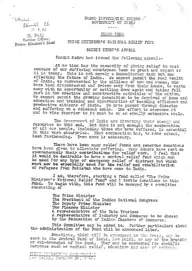Prime Minister's National Relief Fund
Prime Minister's National Relief Fund (PMNRF) in India is the fund raised to provide support for people affected by natural and man made disasters. Natural disasters covered under this include flood, cyclone, earthquake etc. Man made disasters include major accidents, acid attacks, riots etc. The fund is also allotted to the people for treatment like cancer, kidney transplantation, heart surgery etc. The fund was first consolidated during the time of the first prime minister of India Jawaharlal Nehru.[1][2]

History
Partition of British India occurred in 1947 along with the formation of two dominions called Pakistan and India.[2] Partition resulted in mass violence and people were moving across borders in all means. Thus to support the displaced people from Pakistan Jawaharlal Nehru created a fund collected from the public in January 1948.
Implementation
The fund is fully collected from the public and has no budgetary allocation from the government.[1] The fund collected is exempted from income tax to drive more people into the initiative.[3] Chairman of the fund is the Prime Minister and he is assisted by joint secretary. The whole of the fund is deposited with scheduled commercial banks and the beneficiaries are identified directly by the Prime Minister from among the beneficiaries.[3][4]
Impact
The fund was used extensively to provide support for victims of Uttarakhand flood 2013, cyclone in Kerala and Lakshadweep, 2014 violence in Assam, Madhya Pradesh explosion 2015, Tamil Nadu floods 2015 etc.[1]
References
- "PM National Relief Fund | Prime Minister of India". www.pmindia.gov.in. Retrieved 6 June 2018.
- Matthew Statler, K Bradley Penuel (2011). Encyclopedia of Disaster Relief,Volume 2. USA: SAGE. p. 288.
- Sona, Kapila (2006). Academic Foundations Bulletin On Money, Banking And Finance Volume -73 Analysis, Reports, Policy Documents. New Delhi. p. 64.
- Lubna, Kably. "CSR spends to get cos varying tax benefits". Times of india.